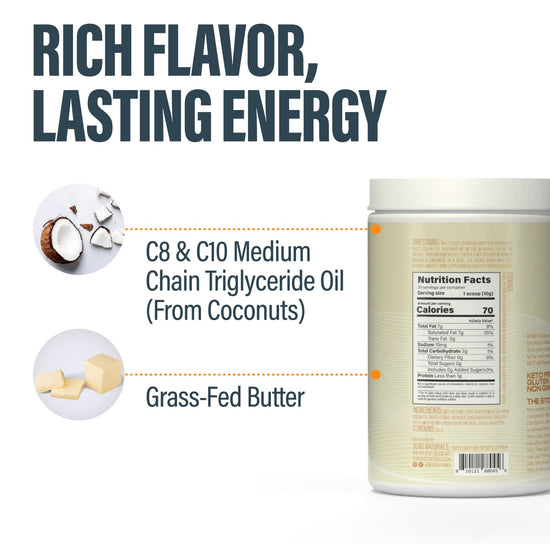Table of Contents
- Introduction
- The Nature of Coffee Acidity
- The Impact of Creamer on Coffee Acidity
- Practical Tips for Reducing Coffee Acidity
- The BUBS Naturals Approach
- Conclusion
- FAQ
Have you ever found yourself sipping on a delicious cup of coffee only to be hit with an unwelcome wave of acidity? If you're like many coffee enthusiasts, you might be curious about the role that your beloved creamer plays in this experience. For those of us who love coffee but are sensitive to acidity, the question arises: does creamer make coffee less acidic?
In this blog post, we will delve into the complexities of coffee acidity, the impact of various coffee ingredients, and how different types of creamers can alter your daily brew. We’ll also explore practical tips on how to enjoy your coffee without the discomfort of acidity, all while honoring the spirit of adventure and wellness that inspires us at BUBS Naturals.
Introduction
For many, coffee is more than just a morning ritual; it’s a beloved companion that fuels our adventures and daily tasks. However, for those with sensitive stomachs or acid reflux, the acidity of coffee can be a real concern. Did you know that coffee typically has a pH level ranging from 4.7 to 5.5? This means it is quite acidic, often more so than fruit juices!
So, why does this matter? Understanding the acidity in coffee not only enhances our appreciation for its rich flavors but also helps us make informed choices about how to enjoy it without discomfort. Creamers, often viewed as mere flavor enhancers, can actually play a significant role in how acidic your cup of joe may feel.
In this post, we’ll explore:
- The nature of coffee acidity and its sources
- How different creamers can affect acidity levels
- Practical strategies for reducing acidity in your coffee
- The importance of choosing quality ingredients, like those found in BUBS Naturals’ product range
By the end of this article, we hope you will have a clearer understanding of how to enjoy your coffee while keeping acidity at bay, so you can savor every sip without worry.
The Nature of Coffee Acidity
Understanding Coffee Acidity
Coffee acidity is often misunderstood. It refers to the bright, tangy flavors that can enhance the overall taste profile of your brew. However, for those prone to stomach issues, these same acids can lead to discomfort. The acidity in coffee is primarily due to several natural acids found in coffee beans, including:
- Chlorogenic Acid: Contributes to the bitter flavor of coffee and decreases during the roasting process.
- Citric Acid: Adds brightness and is more pronounced in lighter roasts.
- Malic Acid: Found in fruits, it imparts a tart flavor.
- Quinic Acid: Formed during the brewing process, it can enhance bitterness.
Understanding these acids can help you tailor your coffee experience. For example, lighter roasts tend to have higher acidity, while darker roasts often have a lower acid content.
The Role of the Coffee Bean
The type of coffee bean you choose also influences acidity levels. Arabica beans, known for their higher acidity and richer flavor, are often favored by coffee aficionados. In contrast, Robusta beans are typically less acidic and have a stronger, more bitter flavor profile. If you're looking for less acidity, opting for Robusta or dark roast Arabica might be a good starting point.
The Impact of Creamer on Coffee Acidity
Can Creamer Curb Acidity?
Adding creamer to your coffee can affect its acidity, but how? Dairy products are generally alkaline, which means they can help neutralize some of the acids present in coffee. When we add cream or milk to our coffee, we are not only enhancing its flavor but also potentially reducing the sensation of acidity.
Here are some common types of creamers and their effects:
-
Dairy Creamers: Whole milk, half-and-half, and heavy cream can effectively neutralize acidity thanks to their alkaline nature. They can create a smooth mouthfeel, making the coffee feel less harsh on the stomach.
-
Plant-Based Creamers: Almond milk, soy milk, and coconut milk are excellent alternatives for those avoiding dairy. Many of these options are also alkaline, and can help balance out coffee’s acidity while adding unique flavors.
-
Specialty Creamers: Some brands offer creamers specifically designed to reduce acidity. These often contain additional ingredients that help neutralize acid without compromising flavor.
Choosing the Right Creamer
When selecting a creamer, consider the following factors:
-
Ingredients: Look for creamers with minimal additives. At BUBS Naturals, we believe in a no-BS approach to ingredients, ensuring that everything we offer is clean and functional.
-
Flavor Profile: Some creamers may add sweetness or other flavors that could enhance your coffee experience. Experiment to find a creamer that complements your preferred roast without overpowering it.
-
Personal Preference: Ultimately, your choice of creamer should align with your taste preferences and dietary needs. Whether you’re looking for a rich, creamy texture or a lighter option, there are plenty of choices available.
Practical Tips for Reducing Coffee Acidity
Brewing Techniques
The way you brew your coffee can significantly influence its acidity levels. Here are some methods to consider:
-
Cold Brew: Cold brewing coffee extracts fewer acids compared to hot brewing methods. The process typically involves steeping coarsely ground coffee in cold water for 12 to 24 hours, resulting in a smoother, less acidic cup.
-
Choose Dark Roasts: Opting for a dark roast coffee can reduce acidity, as the longer roasting time breaks down more acids.
-
Use Coarser Grinds: Coarse grind sizes will allow for less extraction of acidic compounds during brewing, resulting in a gentler brew.
-
Filtered Water: The pH of your water can influence the overall acidity of your coffee. Using filtered water can help mitigate this, leading to a smoother cup.
Adding Creamers and Other Ingredients
Incorporating creamers and other ingredients can make a significant difference:
-
Add Cream or Milk: As discussed, both dairy and plant-based creamers can help neutralize acidity. Consider starting with a small amount and adjusting to taste.
-
Baking Soda: A pinch of baking soda can neutralize coffee's acidity without altering the flavor too much. Just be cautious not to overdo it!
-
Eggshells: This age-old technique involves adding crushed eggshells to your coffee grounds before brewing. The alkaline properties of the shells can help reduce acidity. Just remember to remove them before drinking!
-
Cinnamon: Adding a sprinkle of cinnamon not only enhances flavor but also has natural antacid properties, making your coffee a bit gentler on the stomach.
The BUBS Naturals Approach
At BUBS Naturals, we are committed to supporting your wellness journey with clean, functional supplements. Our products, including our line of Creamers, are designed to mix seamlessly into your daily routine. Each ingredient is chosen with intention, providing you with the energy and nutrition to fuel your active lifestyle.
Explore our Creamers collection to find the perfect blend that helps you enjoy your coffee while keeping acidity in check. Our commitment to quality and simplicity ensures you can sip with confidence.
Conclusion
Coffee can be enjoyed without the discomfort of acidity, and the right combination of beans, brewing methods, and creamers can make all the difference. By understanding the nature of coffee acidity and how creamers interact with it, we can enhance our coffee experience while prioritizing our well-being.
Whether you choose dairy or plant-based options, remember that enjoying coffee is all about balance. So go ahead, experiment with different techniques and flavors, and find what works best for you.
What’s your favorite way to enjoy coffee while managing its acidity? Let us know!
FAQ
Q1: Does adding milk or cream really reduce coffee acidity?
Yes, both dairy and plant-based creamers can help neutralize the acidity in coffee due to their alkaline properties.
Q2: Is cold brew coffee always less acidic?
Generally, yes! Cold brew coffee is known to have significantly lower acidity compared to hot brewed coffee due to the extraction process.
Q3: What are some good low-acid coffee options?
Look for dark roasts or coffee made from Robusta beans, as these tend to have less acidity. Additionally, cold brew is a great option for those sensitive to acidity.
Q4: Can I use baking soda to reduce acidity?
Yes, a small pinch of baking soda can help neutralize acidity without significantly altering the flavor of your coffee.
Q5: How often should I clean my coffee maker?
Regularly cleaning your coffee maker can help reduce any build-up that may add unwanted acidity to your brew. Aim for a deep clean every few weeks, depending on usage.
Written by:
Bubs Naturals

Butter MCT Oil Creamer
BUBS Butter MCT Oil Creamer (formerly Halo Creamer): Scientifically-Backed Brain and Body Fuel
BUBS Butter MCT Oil Creamer is your go-to for clean, fast-acting energy and focus, no crash included. It blends creamy grass-fed butter with fast-acting MCT oil powder (C8 and C10) to kickstart your day and keep you sharp. The MCTs go straight to work, giving your brain a quick boost while the grass-fed butter supports digestion and gut health.
Together, they help curb cravings, keep you feeling full longer, and support steady energy throughout the day—perfect for fueling your mornings or powering through the afternoon slump.
Starts at $37.00
Shop

